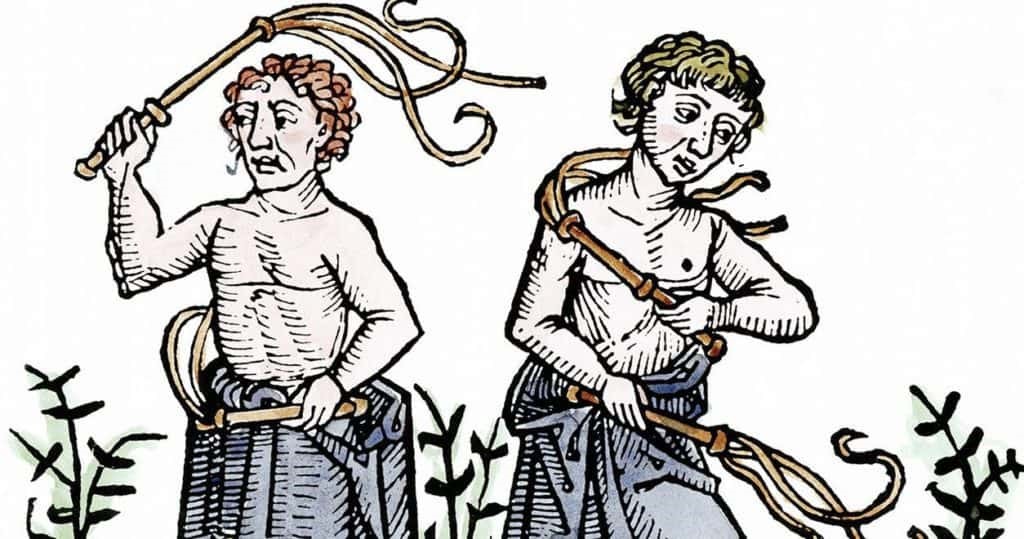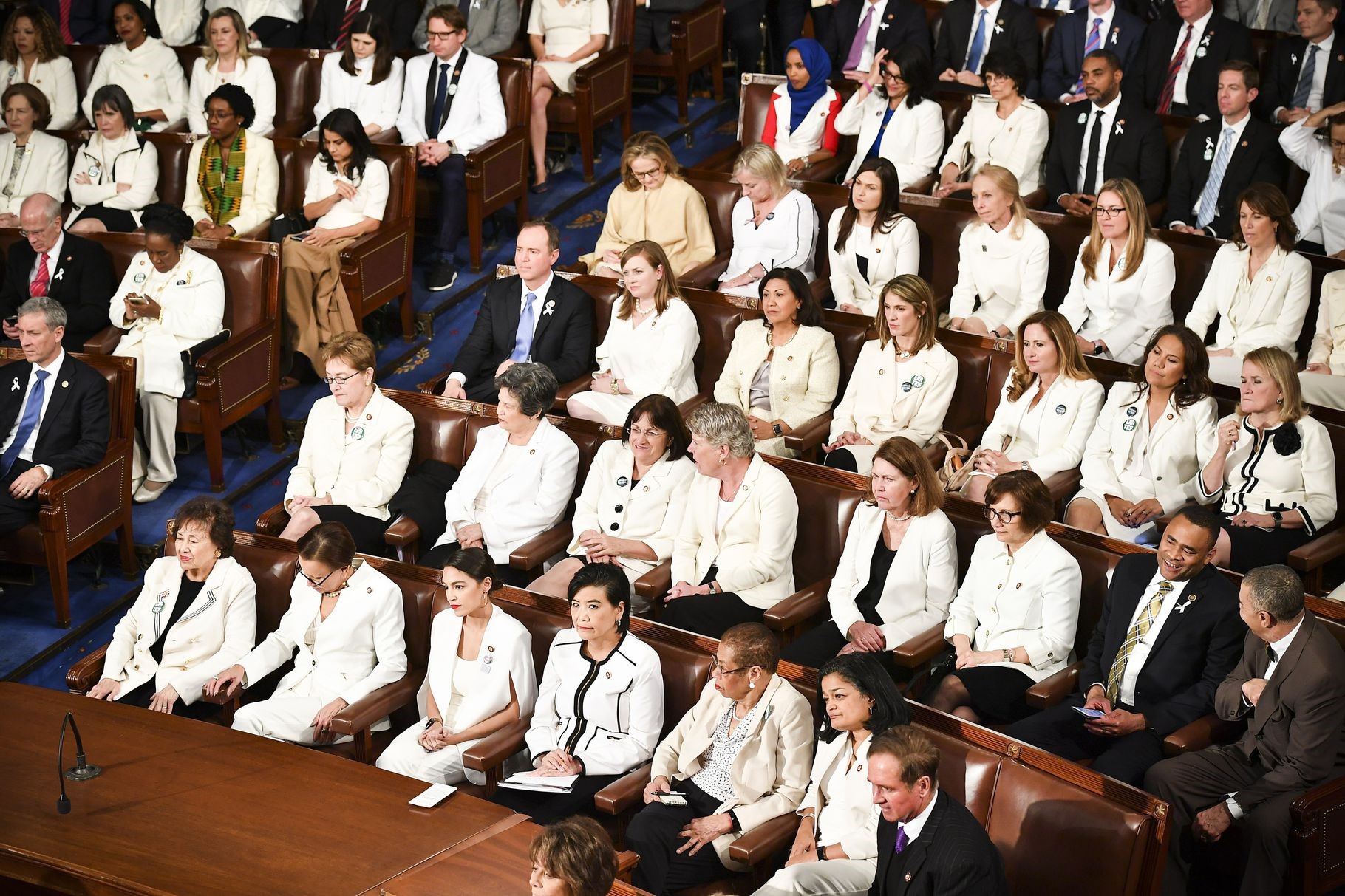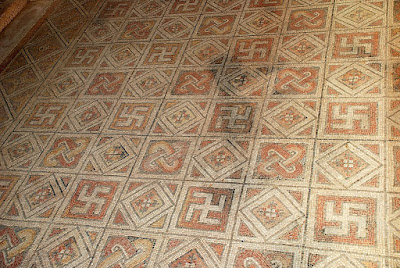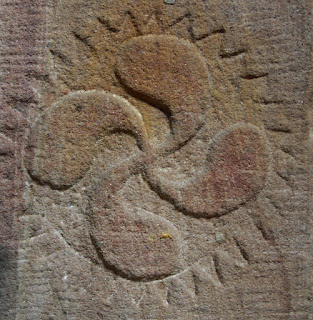Latter-Day Flagellants, Christianity, and the Politics of Evil
June 21, 2020/14 Comments/in Featured Articles /by Andrew Joyce, Ph.D.

“Using these whips they beat and whipped their bare skin until their bodies were bruised and swollen and blood rained down, spattering the walls nearby. I have seen, when they whipped themselves, how sometimes those bits of metal penetrated the flesh so deeply that it took more than two attempts to pull them out.”
Heinrich of Herford, (c.1300–1370)
Enoch Powell, delivering perhaps the most notorious speech of 20th century British politics, warned that “In this country in 15 or 20 years’ time the black man will have the whip hand over the white man.” In much the same way as his demographic projections, the remarkable Enoch was more than a little off on timing, even if there is an obvious truth underlying every aspect of his broader prophetic warning. Britain is, like much of the West, now at a demographic tipping point, and the balance of power between the races is on a knife-edge. But does the Black man, at the present moment, really have the whip hand over the White man? Is it even the case in the United States, where the demographic balance is tipped even more heavily against Whites? I think not. Contemporary Black power in the West, in and of itself, is not self-sustaining but is rather dependent on a vast cultural and legal apparatus that Blacks had little or no role in designing. This apparatus is instead the contrivance of three actors: the Jews; politically, financially, and professionally incentivized Whites; and, finally, pathological and self-flagellating Whites. This last group is undoubtedly the most puzzling and catastrophic element of the current crisis. Much more horrifying than Powell’s utterance is the fact that the White man still holds the whip, but chooses to beat himself with it.
When I first saw images of Whites kneeling for Blacks, washing the feet of Blacks, and otherwise lending themselves to the hysteria of Black sainthood, I was confronted with a sequence of mental images from the distant past. History tells us that plagues are fertile ground for irrational self-sacrifice, and coronavirus, with a little help from the late George Floyd, has not disappointed. Joannes Stobaeus, in his Florilegium, noted that when a plague befell the Spartans “they received an oracle that they would be saved if some Spartans would be selected to be killed by the king.” Clement, in his First Letter to the Corinthians, pointed out that, faced with plagues, “many kings and people in charge, have given themselves to death after listening to an oracle, so that they might save their citizens with their own blood.” Diogenes Laertius, in his Vitae philosophorum, reports that an ancient plague in Athens provoked the killing of “two youths, Kratinos and Ktêsibios, and the suffering was relieved.” Hesiod, in his Works and Days, called for the moral cleansing of the land, and explained famine and plagues in his statement that “The whole state often suffers because of a wicked man, Who transgresses the gods and devises reckless deeds.” Thus, in times of plague, the urge to purge oneself of sins.
Most interesting among the self-sacrificial acts of the past are, in my opinion, that of the flagellants of the Black Death, derisively and scathingly labelled “the gashers” by the Jewish historian Ben-Zion Dinur. The masochistic flagellants, officially known as “Brethren of the Cross,” or “Brotherhood of the Flagellants,” were radical lay Catholics of both sexes (segregated in processions) who first made a major impact in thirteenth-century Germany during the Black Death. Travelling from town to town, they would hold prayers meetings and processions that would culminate in a massive spectacle where they would whip their flesh until the blood flowed, seeking, through this form of self-sacrifice, to avert a broader national calamity.
Although initially supported by the Church, it soon became clear the flagellants were anti-establishment dissidents in every respect. They rejected the authority of priests and clerics, who were regarded by the flagellants as sunk in sin and therefore intrinsic to the problem. The flagellants rejected the Eucharist, asserting that their blood sacrifice was a more authentic communion with Christ. Finally, they revealed their role as populist social revolutionaries by turning against all established elites, including the very wealthy, the nobility, the city leaders and, most interesting of all, the Jews. In fact, everywhere the flagellants went a violent reaction against the Jews followed. In Frankfurt, in July 1349, the flagellants stormed the Jewish neighborhood themselves, and set it on fire. Occasionally, such as in Mainz, when the Jews heard the flagellants were nearing a town or city, the Jews would launch a pre-emptive assault on Christians, with one chronicler reporting the Jews of Mainz slaughtered 200 Christians before the flagellants finally entered and eliminated the Jewish population. Unsurprisingly, the flagellants were quickly denounced as heretics by the existing elite power structure, and were ruthlessly suppressed to extinction throughout Europe.
Latter-Day Flagellants
In stark contrast to the role of the Brethren of the Cross, our latter-day White flagellants are truly birds of a feather with the elite status quo. Those lauding Blacks and subjecting themselves to humiliating acts of politically correct piety have accepted a form of White self-mortification that is entirely beneficial to our elites, and is without any truly redemptive or socially revolutionary features. The flagellants of the past may have acted in an irrational response to disease, but they transmuted this response into concrete social activism that benefited the broader ethnic group — by attempting to topple or undermine harmful and exploitative relationships at the top of society. Latter-day flagellants feign personal mortification, when in reality they cover themselves in temporary social kudos and self-congratulation. Individually, they harm not a hair on their own heads and spill not a drop of blood, but rather seek to ingratiate themselves into a system of social rewards and even financial benefits. And all the while, the personal fakery of these latter-day flagellants rips bloody shreds from the back of the group as a whole, demoralizing the kin group and energizing its enemies. The latter-day flagellants adopt the pose of self-sacrifice and abasement, throwing their racial kin under the proverbial bus in order to exalt themselves, and themselves alone. They avoid any suggestion of personal sin by professing their “anti-racism,” while flinging judgment and condemnation at those who refuse to bend the knee. The reality is that the latter-day flagellants need these refusers in order to look like “exceptions” in the first place.
The question of what to do about behavior like this has deeply troubled me for more than a decade. Thanks to the work of Kevin MacDonald, we certainly know more about its mechanics and origins than at any time previously. It’s now clear that this isn’t a new problem, even if it appears to be getting worse every year. In my own study of “White Pathology and the 1861 Morant Bay rebellion” for the 2013 special edition of The Occidental Quarterly, I was surprised and horrified at sheer callousness that some Whites could show towards their co-ethnics. The Morant Bay rebellion was a horrifically violent episode, with gruesome, extremely painful murders motivated by hatred of Whites. The town of Bowden was plundered, and the island curate “had his tongue cut out while he was still alive, an attempt is said to have been made to skin him.” Another individual “was ripped open and had his entrails taken out.” Others were “roasted alive” and “had their eyeballs scooped out.” According to The Times of London, the mob then indulged in alcoholic excess, harboring the “drunken dream of negro mastery and white slavery. It was Africa, hitherto dormant, that had broken out in their natures. … They desired the extermination of their emancipators.” In my study of the episode and the reactions it provoked in England, I commented:
To the clear-thinking individual, it was a plainly criminal, and unimaginably brutal series of actions, carried out for malicious reasons against a population targeted for being White. And yet, there was a liberal faction in England convinced not only that it was the Black population that were the true victims, but also that their fellow Whites were reprehensible monsters who deserved the fate which befell them. This pathological response, laden with a misplaced hyper-emotionality, would shake the Empire to its core, sapping its confidence, and bequeathing a legacy which is still felt to this day.
The main warriors on behalf of the Blacks were Christian philanthropists who believed that these races could be raised to standards of education and conduct which would place them alongside Europeans. Members of this group tended to be Non-Conformist, middle-class, and liberal or radical in their politics. Crucially, most had never travelled outside Britain, and had little or no experience with the races they so emphatically and persistently eulogized. The movement was centered around Exeter Hall, a residence in London. The term “Exeter Hall” thus became synonymous with what the brilliant Charles Dickens described as “platform sympathy for the Black and . . . platform indifference to our own countrymen.” Dickens wrote:
The Jamaica insurrection is another hopeful piece of business. That platform sympathy with the Black—or the Native, or the Devil—afar off, and that platform indifference to our own countrymen at enormous odds in the midst of bloodshed and savagery makes me stark wild.
It makes me stark wild too. Isn’t it absolutely terrifying that Dickens’s words on the indifference of these universalist elites to the plight of the working classes of their own people are entirely in keeping with what we see today? These people have the appearance of empathy, but not for anyone that looks like himself. Exeter Hall was largely responsible for the production and dissemination of a range of anti-slavery and pro-Black propaganda which, with its heady emotional characteristics, thrived on those under the influence of the Romantic movement. It was of course highly idealistic:
There was also significant involvement in the movement from the Protestant churches. It was the religious arm of Exeter Hall which was responsible for sending mission upon mission to the colonies with the aim of not only saving souls but of “regenerating whole races,” and it was this religious arm, in conjunction with the mainstream propaganda effort, which popularized the idea of the “noble savage” among the congregations of Britain’s churches.
The idea that Whites, particularly Anglo-Saxons, had a divinely ordained mission to raise up the backward peoples of the earth was driven by Exeter Hall’s most basic article of faith—that all peoples could be raised to the same high level of civilization as themselves. Liberals always have a very strong self-concept as morally superior. Moral posturing is, of course, now front and center in the contemporary West. I concluded my piece on Morant Bay by calling attention to an author who watched Steven Spielberg’s Amistad, recalling Whites “squirming in their seats,” and that afterwards a White couple emerged from the theatre “clinging to each other in a desperate attempt to manage the tragedy that had unfolded before them in graphic and picturesque fashion.” The connection is clear:
What we are thus seeing, in this and myriad other instances, is the emotional abuse and torture of a generation of Whites too ill-informed to generate appropriate intellectual or emotional responses to the fictions they are presented with. The dreamscape of Exeter Hall, in which traitors and murderers become national heroes, is entrenched. It has been absorbed, integrated, and assimilated into the White consciousness, and we, the ideological and psychological descendants of Dickens, are relegated to a much-maligned periphery for daring to suggest that the emperor has no clothes.
Placing the blame for pathological levels of self-abasement solely at the feet of Christianity, however, as some in our circles have done, strikes me as all too easy. Jordan Peterson, simultaneously capable of intellectual sublimities and travesties, is absolutely correct in his observation in 12 Rules for Life:
It is true that the idea of virtuous self-sacrifice is deeply embedded in Western culture (at least insofar as the West has been influenced by Christianity, which is based on the imitation of someone who performed the ultimate act of self-sacrifice). Any claim that the Golden Rule does not mean “sacrifice yourself for others” might therefore appear dubious. But Christ’s archetypal death exists as an example of how to accept finitude, betrayal and tyranny heroically — how to walk with God despite the tragedy of self-conscious knowledge — and not as a directive to victimise ourselves in the service of others. To sacrifice ourselves to God (to the highest good, if you like) does not mean to suffer silently and willingly when some person or organisation demands more from us, consistently, than is offered in return. That means we are supporting tyranny, and allowing ourselves to be treated like slaves. It is not virtuous to be victimised by a bully.
There’s no question, however, that many Christian churches have completely folded into patterns of victimizing themselves, or at least engaging in high-kudos superficial acts of self-abasement, in the service of Blacks and the broader culture of critique. There’s also no question that they view such behavior as highly virtuous. In this regard, I found Cardinal Carlo Vigano’s recent letter to Donald Trump on current events to be extremely timely. It’s obvious from the letter, and from his history of activism against Pope Francis, abortion, and the homosexual network at the Vatican, that Vigano is “to the Right” of Trump in every way, but it’s interesting that he attempts to communicate with Trump in Trump’s own language — employing terms such as “Deep State” to try to communicate something far more profound. Most interesting is Vigano’s denunciation of “adversaries, who often hold strategic positions in in government, in politics, in the economy, and in the media.” These adversaries “serve themselves, do not hold any moral principles, want to demolish the family and the nation, exploit workers to make themselves unduly wealthy, foment internal divisions and wars, and accumulate power and money.” He explains that those who help these adversaries are acting out of “self-interest or fearfulness.” This certainly describes the latter-day flagellants, as does Vigano’s condemnation of those within the Church who are “mercenary infidels who seek to scatter the flock and hand the sheep over to be devoured by ravenous wolves … Just as there is a deep state, there is also a deep church that betrays its duties and forswears its proper commitments before God.” For Vigano, who has previously indicated that the Catholic Church had been infiltrated by a combination of Jews, organized homosexuals, and Freemasons, there is a:
media narrative which seeks not to fight racism and bring social order, but to aggravate dispositions; not to bring justice, but to legitimize violence and crime; not to serve the truth, but to favor one political faction. And it is disconcerting that there are Bishops – such as those whom I recently denounced – who, by their words, prove that they are aligned on the opposing side. They are subservient to the deep state, to globalism, to aligned thought, to the New World Order which they invoke ever more frequently in the name of a universal brotherhood which has nothing Christian about it.
I’m not from a Catholic background, and I’ve been very critical of elements and expressions of Christianity in the past, but even I have to concede, that, objectively speaking, Vigano is on to something. One of the most Christian people I know is absolutely disgusted with White behavior for Black Lives Matter, while the most anti-Christian person I know (a friend of a friend) is also the most virtue-signalling, pro-homosexual, pro-miscegenation cretin I’ve ever encountered. There are no simple answers here, and if one is to denounce the Church as the root and cause of some of our major problems, one might as well denounce everything else in Western modernity that’s been co-opted by our adversaries. It should be clear that there wouldn’t be much left that we couldn’t denounce.
The question of why Whites are allowing themselves to be subjected to this kind of treatment on a mass scale, and in some cases encouraging it, rather requires a clear and unflinching view of the mass perception of White identity politics today. Quite frankly, we have been designated the ultimate evil, and no punishment or humiliation will be enough to satisfy our enemies.
The Politics of Evil
One of the most fascinating series of books I’ve read is Jeffrey Burton Russell’s Cornell-published quadrilogy on the concept of evil in Western culture [Satan: The Early Christian Tradition (1981), Lucifer: The Devil in the Middle Ages (1984), Mephistopheles: The Devil in the Modern World (1986), and The Prince of Darkness: Radical Evil and the Power of Good in History (1988)]. These works aren’t just an outstanding exercise in historical and religious scholarship, but also in their analysis of the development of the concept of evil as a political idea. For Russell, who develops the theme to an unmatched degree, there is great power in being able to label one’s opponent and their ideas as evil. To be labelled as being in league with the Devil—or the modern equivalent—is tantamount to political (and in extreme cases, physical) death. If you doubt such an interpretation, just read Dante’s Inferno, which is as much a summary of medieval Florentine politics and a list of Dante’s personal enemies, as it is a piece of religious poetry.
There really is no question about the fact that White identity politics is post-modernity’s only radical political evil, and Adolf Hitler is its Great Satan, looming over a horde of contemporary minor demons. Like Dante’s Inferno, and his various levels of Hell, our contemporary politics is judged morally on the proximity of one’s ideology to that held by the Great Satan in the lowest Hell. Tucker Carlson may be deemed to toil, for example, in the second or third circle, but you readers, with your race pride and anti-Semitism, well, you are beyond all hope in the ninth circle. Our post-religious culture even has a physical substitute for Hell, in the form of a long-abandoned camp in rural Poland.
In the West, what else comes close to this politico-moral taxonomy that borders on the religious in its dogmatic excess? Nothing. Even Islamic terrorism, one of the few aspects of modern life that isn’t readily assimilable by global capitalism, is always qualified in most media and academic treatments as implying some mediating factors, such as Western imperialism, the alienation of Muslim minorities, or any of a wide range of social and environmental causes that are ultimately the fault of Europeans. For those in charge of the national conversation, Islamic terrorism is something explainable and therefore, in the final examination, non-diabolical. By contrast, arguments for internet censorship targeting White identity websites have been advanced by associating White ethnic activism with conduct that is as low and demonic as pedophilia and the very worst of obscene material, which is probably the only other element of our rotten contemporary culture that continues (for now) to be viewed as an example of radical evil. Of all political stances, only the assertion of White ethnic interests is deemed by our mainstream as equally irrational and immoral, being based on the alleged “fantasy” of race and the moral crime of wishing to “dominate” or adopt “supremacy” over other groups.
Whites can prostrate themselves in the name of “anti-racism” because by doing so they’re fighting the religious or secular contemporary incarnation of Satan. Historically, it has been extremely dangerous, and often fatal, to be seen as in league with Satan, and alternatively there have been massive incentives to joining crusades against demonic activity. One thinks of the witch craze, the purging of various heretical sects (including the flagellants), and the experiences of the early Protestants. What we are currently seeing culturally, economically, and politically, is an increasing pressure on people to demonstrate whether or not they are on the side of the Devil. Language such as “White silence is violence,” is increasingly asserting that there is no room for Whites to sit on the fence. Whites must declare whether they are good (subservient) or bad (retaining pride), and regardless of the religious beliefs of these Whites, if any, every cue in our culture is making it extremely clear which side will provide them with incentives and which side is laden with social doom. This is very similar to the process that all cultures undergo when there is a dramatic shift against a certain set of beliefs and/or populations.
The point here is that all conventional strategies designed to move White dissident thought from the fringe to the mainstream may be doomed to failure because they neglect the fact we aren’t even on the same spectrum of political possibility, or even within the same psychological framework. We are exiles, declared to be total anathema. To label something evil is to imply it is willfully engaged in the chaotic, unnatural, and sadistic. Evil implies an unregenerate irrationality as well as a complete detachment from morals. It also implies the willful infliction of suffering, and perhaps also a joy in it. Fighting from this position with appeals to things like IQ differences, crime rates, the data on police shootings of Blacks and Whites, or blandishments about the right of all peoples to self-determination, is probably entirely pointless.
Ultimately, the mainstream narrative about White identity politics is based on unreason and outright falsehood. An edifice built so obviously on an emotive disdain for facts and objective reality will be entirely unmoved by rejoinders employing them. Accusations of Leftist hypocrisy are as ubiquitous as they are ineffective, because ultimately people on the Left, or Right for that matter, don’t really care about what is correct or incorrect, or at least don’t care enough to do something meaningful about it. What they do care about is what is “evil,” and if they can look good and get rich fighting it then all the better. What is really required, therefore, is a “fight fire with fire” strategy that embodies emotionality and triggers psychological responses that resonate on a deeper level, beyond consciousness. This necessitates a propaganda designed exclusively to instill feelings of disgust, fear, and hatred for those opposed to White interests. In the final analysis, it must be hammered home that our opponents are not wrong, weak-willed, venal, or corrupt — they are morally, politically, and spiritually evil. They belong in the lowest Hell.
I understand the necessity of framing our arguments in reasonable terms. I understand the value of producing evidence, and presenting facts. But I also understand that these things have limited tactical value. The symbiotic elites of medieval Germany were safely ensconced in their centers of power until the flagellants came to town, with their emotive, violent, grisly, and gloriously fanatical denunciations of evil. Within that environment, riding on the crest of a crisis, the heretics and rebels became the arbiters of truth and the judges of society. Dispute as you will their claim to have banished the Devil, but can you deny they banished, even for a short time, at least some social evils?
Looked at from an angle not dripping with footnotes and statistics, isn’t it clear that our opponents are, in some sense, crawling with “demons”? Aren’t they riddled with the most malevolent of intentions? Don’t they bleat endlessly about eugenic policies of yesteryear while paving the way for “after-birth abortion.” They’re not wrong, my friends, they’re evil.

Our moral superiors: Dressed in White and dripping with blood



